 |
| |
MI6 trawls the archives to see how critics of the day received Pierce Brosnan in the 1999 adventure "The World Is Not Enough"...
|
|
Time Tunnel: Review Rewind
7th January 2010
New York Times - November 19th, 1999
"The World Is Not Enough" was directed by Michael Apted, whose insightful glimpses of the maturing process can be seen in his latest documentary, "42 Up." Doggone if Mr. Apted hasn't been able to make James Bond grow up a little too. In his third and most comfortable effort to model the Bond mantle, Pierce Brosnan bears noticeably more resemblance to a real human being. He shows signs of emotion, cuts back on the lame puns and makes lifelike conversation with fellow characters. Should he ever stop posing mannequinlike with left hand in trouser pocket, or engage in a clinch without appearing to be promoting his wristwatch, Mr. Brosnan's Bond will have entered the land of the living.
This latest film, which
evokes its jolliest laugh when Bond tries to work the title
phrase into a conversation, seems to be populated by more
noticeable people all around.
Back at initial-filled headquarters,
M (Dame Judi Dench) takes a more active role in this
story, while the delightful Q (Desmond Llewelyn) is now
made even
more so by John Cleese's R. Both men are suitably aghast
whenever Bond runs off with their newly designed equipment
and treats it as if he were a teenager who shouldn't
have borrowed the car.
The film is off to the races with its
obligatory high-octane opening. This year's model features
the Frank Gehry-designed museum in Bilbao, Spain, an amphibious
chase through London and a hot-air balloon. And it pits
Bond against a woman in tight red leather who drives a
speedboat while shooting a machine gun. (Question: Isn't
it difficult to do both?)
The chase ends tragically, with
a cryptic line of dialogue. (Question: Will anyone know
what her problem was when the movie is over?)
Right: Bond fends off Renard's heavies in the Nuclear Decommissioning Facility. |
|
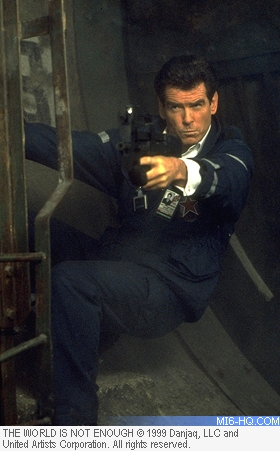
|
Still trawling for plausible villains, "The World Is Not Enough" pits Bond against Renard (Robert Carlyle), a rabid anticapitalist terrorist who has a bullet in his head. (Question: Is the large, mobile, computer-generated hologram of Renard's skull and brain more interesting than the actual character?) Renard was once the kidnapper of beautiful Elektra King, whose beloved father (note her first name) is blown up before this film's opening credits. When a character here explains that Elektra fell in love with her captor, the phrase "Stockholm syndrome" is used nervously. It's as if the movie's real goals of admiring scenery and plugging products were jeopardized by such a knotty concept.
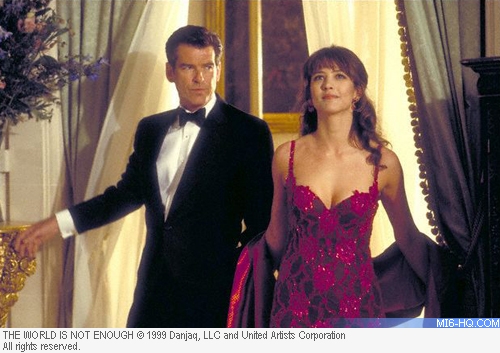
Above: Bond shadows Elektra at casino.
|
Sophie Marceau does a smashing turn as Elektra, in a mischievously sexy performance that manages to make Bond that much more interesting. While Ms. Marceau gets the slinky costumes, gorgeous ski sequence and boudoir scenes, the film's other female star fares less well. Denise Richards seemed far more clever as the teenage vixen of "Wild Things" than she does as a brilliant scientist whose name (Dr. Christmas Jones) is mercifully avoided in conversation. And she's the one who gets stuck talking about plutonium and flailing away on a soggy submarine.
The plot, which often sends the audience into a pleasant fog while big machines and deadly weapons are thrown around, involves the struggle over an oil pipeline (with Robbie Coltrane as an amusing Russian gangster) and sends postcards from places as diverse as Scotland and central Asia. (Question: Is it easy to rent a shiny new BMW if you're in Azerbaijan? It is if you're James Bond.)
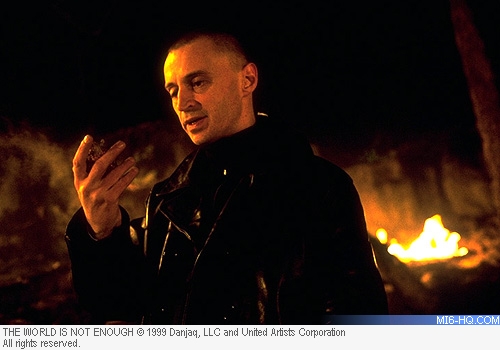
Above: Robert Carlyle as the 'senseless' terrorist Renard.
|
Variety - November 15th, 1999
"The World Is Not Enough," and neither is this new entry in the James Bond cycle. Although not without its moments, particularly an exciting pre-credits high-speed boat chase and some solid work by the nicely matched Pierce Brosnan and Sophie Marceau, 19th assignment of Bond's 37-year screen career sees 007 undone by villainous scripting and misguided casting and acting in a couple of key secondary roles. Underachievement will probably only occasion a moderate B.O. dip for the series (first two Brosnan starrers, "GoldenEye" and "Tomorrow Never Dies," grossed a series-best $353 million and $345 million worldwide, respectively), but it should put producers on notice to do better next time around.
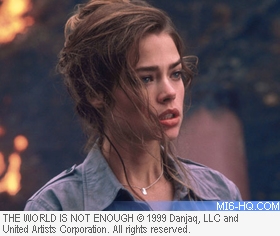
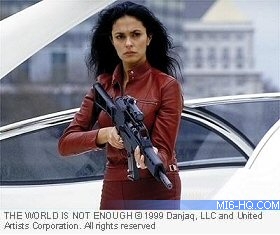
Above: (top) Denise Richards as Dr. Christmas Jones and (below) Maria Grazia Cucinotta as the assassin Cigar Girl.
|
|
Daft, over-crammed plotting is a shame, because Brosnan grows noticeably more comfortable in the role with each outing, and here reveals a strong urge to make the most of his admittedly scant opportunities to invest Bond with interesting shadings and substance. The secret agent this time has an appealing vulnerable side, not only a physical one in the form of a dislocated collar bone but in a growing susceptibility to Marceau's character, who is more his match than any woman he's met in quite a while.
There is a palpable sense of strain in the
script to come up with new set piece ideas, and one of the
problems is that there are too many of them. But it's impossible
to take issue with the opening, which, at 15 minutes, must
rate as the longest Bond prologue ever.
Set in Bilbao, Spain,
for the sole and entirely justifiable reason of using Frank
Gehry's new Guggenheim Museum as scenery, story launch
has Bond come to collect a large stash of money recovered
from
a killed MI6 agent.
After 007 narrowly escapes death there,
he returns to London with the loot, only to see its rightful
owner blown up, sending Bond into a wild chase aboard a
jet speedboat on the Thames that winds up -- where else?
-- on
top of the new Millennium Dome at Greenwich. It's an exhilarating
sequence, one that sets up expectations that are unfortunately
not matched on the rest of the trip. |
The man with the money, it turns out, was a wealthy industrialist whose daughter Elektra (Marceau) will now inherit his vast holdings, which include an unfinished oil pipeline across Western Asia to Istanbul. Elektra also has a history with Bond's boss M (Judi Dench), who botched a rescue attempt of the young woman when she was held by a terrorist kidnapper, from whom Elektra subsequently escaped.
As Elektra seems a likely target of any number of rivals in the former Soviet Union, Bond heads for the picturesquely ugly oil fields of Azerbaijan to protect her, which he needs to do the moment she takes him skiing and they're attacked by machine-gunning marauders in airborne parahawks that become speedy snowmobiles once they've landed.

Above: Sophie Marceau poses for a publicity still on the set of the Elektra's Baku home.
|
A visit to the casino in Baku enables James not only to order a martini, but also to try out some nifty X-ray specs that not only permit him to see that nearly everyone there is packing, but also to check out the ladies' undergarments. It's one of the film's cleverest little inventions, one that could have been judiciously built into a nice running gag.
But just as James and Elektra find one another, her old tormentor, the terrorist Renard (Robert Carlyle), turns up. Not only are his plots now infinitely more dastardly, but he has nothing to lose -- a bullet deeply lodged in his brain, which will one day kill him, has severed nerves so that he feels no pain, and it also makes him stronger. Unlike the see-through glasses, this scripting brainstorm seems not so clever, making Renard too much of a freaky sci-fi character and saddling the gifted Carlyle with a silly role that is more annoying than imposing in the best Bond tradition.
Much further beyond the
pale, however, is "Starship Troopers" and "Wild
Things" bimbette Denise Richards in the role she was
born to play -- a high-level nuclear weapons expert
Prancing
around a rugged work site in regulation nuke scientist
shorts and midriff-revealing shirt, Richards tries to
look all business but can't be anything but what she is,
the
token Yank in the cast cluelessly flailing about and
certainly unable to hold her own with her more mature co-stars.
Nonetheless, she's asked to be convincing at disarming a nuclear warhead while hurtling with Bond through an oil pipeline at express speed. Even within the fantasy context of the Bond world, nearly everything about her character is a joke, including her name, Christmas Jones, which at least provides what's needed for the film's groaningly funny sign-off line.
Action grows murky and rather tiresome in the second half, with at least one set piece too many -- pic is far too infatuated with a pair of buzz-saw-dragging helicopters -- and excessive liberties taken with Bond invisibly transporting himself from one remote location to another in the blink of an eye. |
|
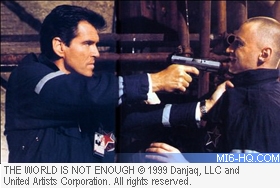
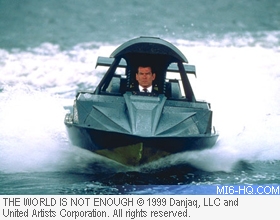
Above: (top) Bond confronts renard and
(below) he chases the Cigar Girl down the Thames.
|
M is intriguingly brought to the site of the suspense climax in Istanbul, only to be cast aside in a cell. A major opportunity is missed in not having her execute the coup de grace to one of the villains (which would have made much more psychological and emotional sense) instead of Bond.
Final combat aboard a submerged nuclear sub merely demonstrates once again that water puts a literal damper on action sequences.
While Bond buffs had widely speculated what a name director like Michael Apted might add to the proceedings, the answer is: very little. Staging of the dramatic sequences is capable but straightforward, although it is possible that Apted might have urged Brosnan in the encouraging direction indicated here. As Rene Russo did in "The Thomas Crown Affair," Marceau squares off very nicely opposite the star, displaying a confident ease in English-lingo thesping.
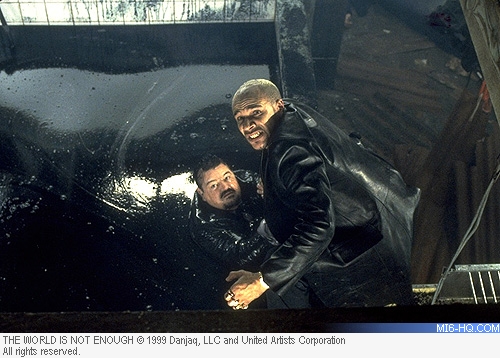
Above: The Bull rescues his boss, Zukovsky from his Caviar on the edge of the Caspian.
|
Robbie Coltrane reprises the Sidney Greenstreetish role of the rotund criminal businessman Valentin Zukovsky that he originated in "GoldenEye," while the usual MI6 crowd is back along with the surprising addition of a cheeky John Cleese as R, the assistant and heir apparent of the ancient Desmond Llewelyn's ever-inventive Q.
"World" has the customary Bond look and sound, which represent cozy satisfactions unto themselves.
EW - May 19th, 2000
In his third outing as James Bond, Pierce Brosnan finally imprints his own personality on the role. Just in time too, because his smoother, cooler superspy proves the sturdiest aspect of The World Is Not Enough — which tentatively tries to shake up the formula without really stirring the foundation.
And so, as 007 zips around the globe protecting a gorgeous oil heiress (Sophie Marceau) from a nutzoid terrorist (Robert Carlyle), we meet Q's permanent replacement (John Cleese), see the usually deskbound M (Judi Dench) out in the field, and get a bad Bond girl who actually steals Bond's heart.
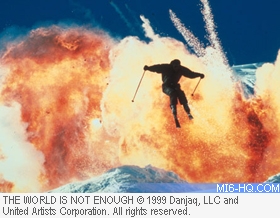
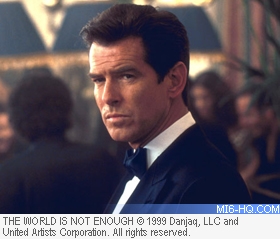
Above: (top) Bond narrowly escapes a grenade blast and (below) surveys the Baku nightlife.
|
|
Unfortunately, Bond's world hasn't changed enough. His double entendres are, if anything, lamer than usual. So is the movie's ''good'' Bond girl, Dr. Christmas Jones (Denise Richards), a pouty nuclear physicist in short shorts, who ranks as this series' most improbable Ph.D. since Moonraker's Dr. Holly Goodhead. What were the filmmakers thinking? What were they thinking with?
Maybe it's for the best that this movie's convoluted plot turns Marceau to the dark side. A soulful, sensual femme fatale with complex motivations, Marceau gives Bond a real woman to deal with for once. That's almost more change than a James Bond film can handle.
Chicago Sun Times - November 19th, 1999
"The World Is Not Enough" is a splendid comic thriller, exciting and graceful, endlessly inventive. Because it is also the 19th James Bond movie, it comes with so much history that one reviews it like wine, comparing it to earlier famous vintages; I guess that's part of the fun. This is a good one.
Instead of summarizing the plot, let's tick off the Bond trademarks and see how they measure up: 1. Bond himself. Pierce Brosnan. The best except for Sean Connery. He knows that even the most outrageous double entendres are pronounced with a straight face. He is proud that a generation has grown up knowing the term "double entendre" only because of Bond movies. |
2. Regulars. There's real poignancy this time, because Q, the inventor of all of Bond's gizmos, is retiring. Desmond Llewelyn has played the character in every single Bond film since "From Russia With Love" in 1963 (with the exception of "Live and Let Die" in 1973, when the producers dropped Q after an insane decision that the series needed less gimmicks). Llewelyn is now 85, and after demonstrating a few nice touches on his latest inventions, he sinks from sight in an appropriate and, darn it, touching way.
3. Guest stars. Who could replace Q? John Cleese, of course. "Does this make you . . . R?" asks Bond, after Cleese demonstrates a BMW speedster with titanium armor "and six cup holders."
4. M. Judi Dench is back for the third time as Bond's boss M, with the same regal self-confidence she displayed as queens Elizabeth ("Shakespeare in Love") and Victoria ("Mrs. Brown"). She does not condescend to the role, but plays it fiercely, creating an intelligence chief who actually seems focused and serious, even in the uproar of a Bond plot.
5. Sex bombs. Usually two major ones, a good girl who seems bad, and a bad girl who seems good. Both first-rate this time. Sophie Marceau plays Elektra King, daughter of a tycoon behind an oil pipeline linking the old Soviet oil fields to Europe. Denise Richards plays Christmas Jones, a nuclear scientist whose knowledge can save or doom the world. I will not reveal who is bad-good or good-bad.
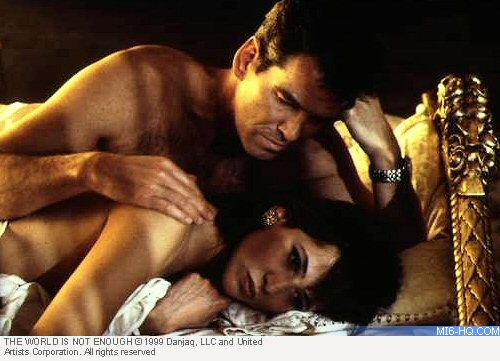
Above: Pierce Brosnan and Sophie Marceau shoot the romantic scene.
|
6. Chase sequences. Lots of them. By powerboat on the Thames (and across dry land, and back on the Thames) and then into a hot-air balloon. By skis down a mountain, pursued by hang-gliding, bomb-throwing para-sailers whose devices convert into snowmobiles. By land, in the BMW. Under the sea, as Bond breaks into a submarine and later pursues a villain by popping outside the sub and then in again.
7. Megalomaniacal villains. There is a terrific early appearance of the arch-terrorist Renard (Robert Carlyle). His oversized skull rises from the floor in a hologram, and then takes on flesh. M explains that a bullet in his brain is gradually robbing him of his senses, but that "he'll grow stronger every day until he dies." Bond walks around the hologram and reaches inside Renard's head to trace the path of the bullet. Another villain is played by Robbie Coltrane, who gets mileage out of always seeming like he'd really prefer to be a nice guy.
8. Locations. Not simply the oil field of Azerbaijan, but Frank Gehry's new Guggenheim Museum in Bilbao, Spain, which figures in a nifty opening sequence, and the Millennium Dome on the banks of the Thames, which becomes a landing pad after a balloon explodes. Also a Hindu holy place with flames that never die.
9. Weird ways to die. How about vivisection by helicopter-borne rotary tree-trimming blades? Or garroting in an antique torture chair? 10. Sensational escapes. There is nothing like a Bond picture to make you believe a man can safely bungee-jump from a tall building, after tying one end of a window shade cord to his belt and the other end to an unconscious body.
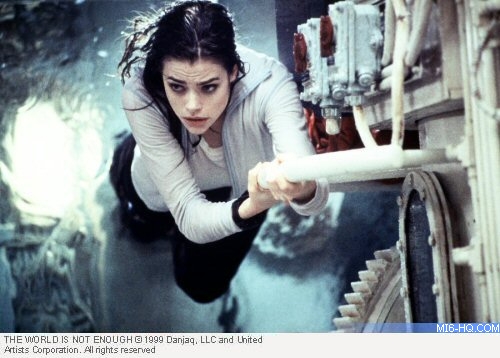
Above: Dr Christmas Jones is caught in the quickly flooding submarine.
|
All of these elements are assembled by director Michael Apted and writers Neal Purvis, Robert Wade and Bruce Feirstein into a Bond picture that for once doesn't seem like set pieces uneasily glued together, but proceeds in a more or less logical way to explain what the problem and solution might be. Bond's one-liners seem more part of his character this time, and Carlyle's villain emerges as more three-dimensional and motivated, less of a caricature, than the evildoers in some of the Bond films.
My favorite moment? A small one, almost a throwaway. The movie answers one question I've had for a long time: How do the bad guys always manage to find all their equipment spontaneously, on remote locations where they could not have planned ahead? After the snow chase sequence, a villain complains morosely that the para-sails were rented, and "were supposed to be returned."
Related Articles
 The World Is Not Enough - Full Coverage
The World Is Not Enough - Full Coverage
 Time Tunnel Index
Time Tunnel Index